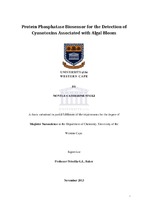| dc.contributor.advisor | Baker, Priscilla | |
| dc.contributor.author | Mniki, Nontle Catherine | |
| dc.date.accessioned | 2014-09-04T12:54:38Z | |
| dc.date.available | 2014-09-04T12:54:38Z | |
| dc.date.issued | 2013 | |
| dc.identifier.uri | http://hdl.handle.net/11394/3628 | |
| dc.description | Magister Scientiae - MSc | en_US |
| dc.description.abstract | The toxicity of microcystin is associated with the inhibition of serine/threonine protein phosphatases 1 and 2A, which can lead to hepatocyte necrosis and haemorrhage. Analysis of microcystin is most commonly carried out using reversed-phase high performance liquid chromatographic methods (HPLC) combined with ultra-violet (UV) detection .The ability of these techniques to identify unknown microcystin in environmental samples is also restricted by the lack of standard reference materials for the toxins. Highly specific recognition molecules such as antibodies and molecularly imprinted polymers (MIPs) have been
employed in the pre-concentration of trace levels of microcystin from water and show great potential for the clean-up of complex samples for subsequent analysis. New biosensor technologies are also becoming available, with sufficient sensitivity and specificity to enable rapid ‗on-site‘ screening without the need for sample processing. In this work we constructed a Protein phosphatase biosensor for detection of microcystin-LR in aqueous medium, onto polyamic acid/graphene oxide (PAA: GO) composite electrochemically synthesised in our laboratory. The composites were synthesised at three different ratios i.e. 50:50, 80:20 and 20:80 to evaluate the effect of each component in the search to produce highly conductive mediator platforms. The electrochemistries of the three different composites were evaluated using CV and SWV to study interfacial kinetics of the
materials as thin films at the glassy carbon electrode. The phosphatase biosensor parameters were evaluated using CV, SWV, EIS and Uv-vis spectroscopy. The affinity binding of the microcystin-LR to protein phosphatase 2A was investigated using electrochemical impedance spectroscopy which is a highly sensitive method for measuring interfacial kinetics of biosensor systems. | en_US |
| dc.language.iso | en | en_US |
| dc.subject | Protein phosphatase1 and 2a | en_US |
| dc.subject | Polyamic acid | en_US |
| dc.subject | Graphene oxide | en_US |
| dc.subject | Microcystin-LR | en_US |
| dc.subject | Biosensor | en_US |
| dc.subject | Cyanotoxins | en_US |
| dc.subject | Cyclic voltammetry | en_US |
| dc.subject | Uv-vis spectroscopy | en_US |
| dc.subject | Atomic force microscopy | en_US |
| dc.subject | Scanning electron microscopy | en_US |
| dc.subject | Electrochemical impedance spectroscopy | en_US |
| dc.subject | Enzyme linked immunosorbent assay | en_US |
| dc.title | Protein phosphatase biosensor for the detection of cyanotoxins associated with algal bloom | en_US |
| dc.rights.holder | uwc | en_US |

